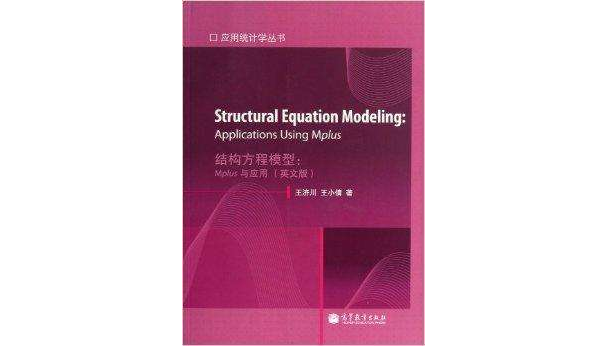《結構方程模型:Mplus與套用(英文版)》以通俗易懂的方式系統地闡述結構方程模型的基本概念和統計原理,側重各種結構方程模型的實際套用。《結構方程模型:Mplus與套用(英文版)》採用國際著名SEM軟體MplUS,使用真實數據來演示各種常見的以及某些新近發展起來的較高級的結構方程模型,提供相應的Mplus程式,並詳細解讀程式輸出結果。參照《結構方程模型:Mplus與套用(英文版)》提供的例題和相應的電腦程式,讀者便能自己實踐各種SEM模型。
基本介紹
- 書名:結構方程模型:Mplus與套用
- 作者:王濟川 王小倩
- 出版日期:2012年8月1日
- 語種:簡體中文, 英語
- ISBN:9787040348286, 7040348284
- 外文名:Structural Equation Modeling:Applications Using Mplus
- 出版社:高等教育出版社
- 頁數:453頁
- 開本:16
- 品牌:高教社
內容簡介
圖書目錄
1 Introduction
1.1 Model formulation
1.1.1 Measurement model
1.1.2 Structural model
1.1.3 Model formulation in equations
1.2 Model identification
1.3 Model estimation
1.4 Model evaluation
1.5 Model modification
1.6 Computer programs for SEM
Appendix 1.A Expressing variances and covariances among observed variables as functions of model parameters
Appendix 1.B Maximum likelihood function for SEM
2 Confirmatory factor analysis
2.1 Basics of CFA model
2.2 CFA model with continuous indicators
2.3 CFA model with non—normal and censored continuous indicators
2.3.1 Testing non—normality
2.3.2 CFA model with non—normal indicators
2.3.3 CFA model with censored data
2.4 CFA model with categorical indicators
2.4.1 CFA model with binary indicators
2.4.2 CFA model with ordered categorical indicators
2.5 Higher order CFA model
Appendix 2.A BSI—18 instrument
Appendix 2.B Item reliability
Appendix 2.C Cronbach's alpha coefficient
Appendix 2.D Calculating probabilities using PROBIT regression coefficients
3 Structural equations with latent variables
3.1 MIMIC model
3.2 Structural equation model
3.3 Correcting for measurement errors in single indicator variables
3.4 Testing interactions involving latent variables
Appendix 3.A Influence of measurement errors
4 Latent growth models for longitudinal data analysis
4.1 Linear LGM
4.2 Nonlinear LGM
4.3 Multi—process LGM
4.4 Two—part LGM
4.5 LGM with categorical outcomes
5 Multi—group modeling
5.1 Multi—group CFA model
5.1.1 Multi—group first—order CFA
5.1.2 Multi—group second—order CFA
5.2 Multi—group SEM model
5.3 Multi—group LGM
6 Mixture modeling
6.1 LCA model
6.1.1 Example of LCA
6.1.2 Example of LCA model with covariates
6.2 LTA model
6.2.1 Example of LTA
6.3 Growth mixture model
6.3.1 Example of GMM
6.4 Factor mixture model
Appendix 6.A Including covariate in the LTA model
7 Sample size for structural equation modeling
7.1 The rules of thumb for sample size needed for SEM
7.2 Satorra and Saris's method for sample size estimation
7.2.1 Application of Satorra and Saris's method to CFA model
7.2.2 Application of Satorra and Saris's method to LGM
7.3 Monte Carlo simulation for sample size estimation
7.3.1 Application of Monte Carlo simulation to CFA model
7.3.2 Application of Monte Carlo simulation to LGM
7.3.3 Application of Monte Carlo simulation to LGM with covariate
7.3.4 Application of Monte Carlo simulation to LGM with missing values
7.4 Estimate sample size for SEM based on model fit indices
7.4.1 Application of MacCallum, Browne and Sugawara's method
7.4.2 Application of Kim's method
References
Index

